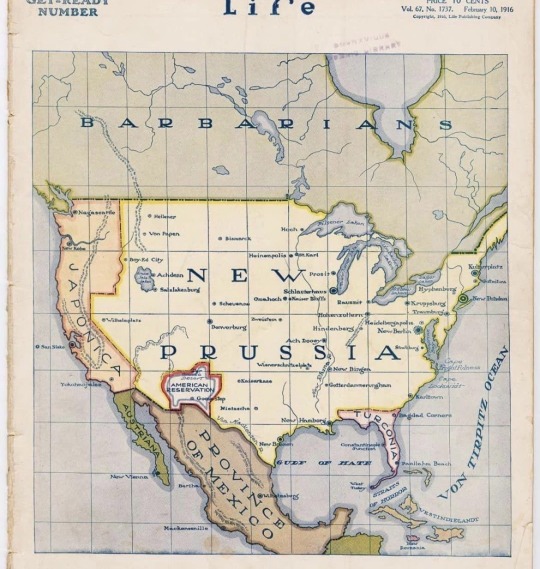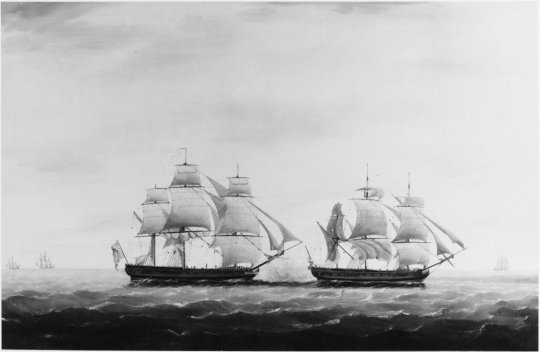Text
Aight so according to the Cornell Library, this is real (source), though the Axis was WWII, not WWI. Japan was also an ally of Britain in WWI and had declared war on Germany in 1914, so best I can figure is the concern over “Japonica” stems from Japanese expansion into the Pacific.
The US claimed neutrality in WWI for, among other reasons, its policy of isolationism and a strong pro-German sentiment, particularly from German immigrants. In 1916, the date of publication here, the official policy was still that of neutrality. Life magazine ran this political cartoon anyway- the top is cropped slightly but the caption in the left corner reads “get ready” — propaganda to serve as both warning and call to arms.
Anyway. There’s a lot to unpack here, could make for a fun short essay question, but I am a busy being so instead: tag yourself, I’m Wienerschnitzelplatz.

Propaganda made by the allies of WW1 of what could happen to the United States if the axis won.
10K notes
·
View notes
Text
✨Museum Asks✨
Submit an ask with one (or more) of the numbers bellow, and the Museum Desk Staff will answer them!
1. What is your favorite thing about museums?
2. What is the museum that you most want to visit (that you’ve never been to before)?
3. What’s the coolest thing that you’ve seen at a museum?
4. What’s the weirdest thing that you’ve seen at a museum?
5. If you could create a museum about one thing, what would it be?
6. What is your favorite thing to buy from museum gift shops?
7. If you could dedicate a museum to one artist, who would it be?
8. If you could have a behind the scenes tour of any museum, which one would you pick?
9. What historical artifact (that you haven’t seen) would you like to see in person?
10. What piece of art (that you haven’t seen) would you like to see in person?
11. Do you like art museums or history museums better?
12. Do you like history museums or natural history museums better?
187 notes
·
View notes
Note
Ok so I like boys and I might be a trans dude but I’m really attracted to the lesbian label idk why but aaa isnsuhsuwnsus Idk what to do what is wrong with me please help me
I have the same problem with the term ‘butch’, I really like it but I’m not a lesbian so I can’t exactly use it
so instead I just call myself a sparrow stag (meaning a sorta low-maintenance masculine nb)
59K notes
·
View notes
Note
Controversial opinion, but I do think that people should be forced to learn how to use databases and find information online instead of being spoon-fed by an algorithm. It's about requiring people to think for themselves and make their own choices. I don't want a community of passive pawns. It's bad for fandom, and it's bad for all of society.
--
Controversial?
Dude, people should be forcibly taught that because it's a standard part of school.
I know I had a whole class period as a freshman in high school about how to use the card catalogue and the various digital searching methods of the day in our school library. I dimly remember various classes from grade school that explicitly taught us how to do research: how to seek out sources, how to evaluate them for reputability, how to cite them, etc.
No one is born with critical thinking or researching skills. They're something a decent school can easily teach, but you do have to teach them.
Just... a lot of schools are 1. crap and 2. way overloaded so people fall through the cracks a lot.
Should people here write up guides on how to do research or database searches? Sure. Link me and I'll reblog them. Someone in the reblogs even requested that kind of help within the last few days. The interest is there, even if not from everyone.
Actually, one of Tasting History's most recent episodes was all about this (vetting sources and realizing when you fell for bullshit because it's now deeply embedded in otherwise reputable sources). It's definitely a topic people still care about, and if school is falling down on the job, somebody else is going to have to step up.
So, yes, I agree with you, and I further think that the only reason this isn't already universally happening is that a lot of people were failed by their local educational systems.
785 notes
·
View notes
Text
An Enslaved Black Sailor of the American Revolution?
I'm currently in the midst of transcribing an 18th-century account book owned by Lt. Richard Dodge of Wenham, Massachusetts. The account book details all labor/goods transactions between Lt. Dodge and his neighbors throughout the 1750s-1770s in this small predominantly agricultural community on the North Shore of Boston. My main interest in the accounts are the entries referencing the labor of Wenham's enslaved population. The Dodges were wealthy landowners and they enslaved men, women, and children in the 18th century throughout Essex County, Massachusetts.
One name I keep seeing in the accounts is Hampshire. He was the son of Hazard and Flora, a couple also enslaved by Lt. Dodge. In the 1760s and 1770s Hampshire was recorded performing a variety of labor for the Dodges, including hauling rocks and dung, cutting up wood, mowing, breaking up the ground for planting, working the mill, and carrying freight. The image below shows him (as "Hamsheair") mowing for "part of a Day."

Whenever I'm researching anyone in history, I do a Google search of their name in case they were mentioned in a book some kind soul has digitized. When I Googled "Hampshire Dodge," that is, Hampshire's first name plus his enslaver's surname, I came up with a very interesting hit: a 1777 crew list for the Continental Frigate Boston (see the entire book, Captain Hector McNeill of the Continental Navy here).
You can see the entry for Hampshire Dodge circled in red. It shows he was assigned to the larboard watch, and gun N 10.
Interestingly, on the same page are entries for men whose first names stand out as common names imposed upon enslaved African-descended men in the 18th century in New England: Nero Freeman, Cuff Freeman, and Caesar Fairweather. I've circled their names in yellow.

It's likely Nero and Cuff, judging by their surnames, were free when they shipped out on the Boston: it was common in New England for formerly enslaved people to take the surname "Freeman," or another surname of their own choice, rather than retain the surname of their enslaver.
It wasn't at all unusual for enslaved men to volunteer--or be volunteered--for service in the American Revolution, especially in New England. You can view and download the truly impressive Forgotten Patriots project to learn more. In the spring of 1775, Lt. Richard Dodge's son Richard Jr. became the captain of a company in the regiment of Colonel Samuel Gerrish of Newbury, and one of the men Richard Jr. enslaved, Scipio Dodge, fought alongside him. Hampshire heading off to sail in service on Boston would not have been far-fetched at all considering all of the patriotic fervor in the immediate Dodge family.

Boston would have been a brand new vessel when Hampshire sailed on her, launched from Newburyport, Massachusetts in 1776 and completed in 1777, just in time to accompany Hancock and American Tartar on a run up the coast of the North Atlantic. As far as the Dodge account books report, Hampshire had no previous experience at sea, though he may have plied one of Lt. Dodge's "canoues" through shallow local waterways. He was about to learn seamanship on his feet.

After aiding Hancock in capturing HMS Fox in a broadside attack on June 8, 1777 (above image), Boston found itself, one short month later, on July 8, 1777, in the crosshairs of the 44-gun HMS Rainbow, HMS Flora and HMS Victor. Fox, Hancock, and Boston immediately sailed in different directions so as not to provide an easy target for their pursuers. Fox was taken first after a short fight, and Hancock surrendered soon after, her captain possibly fearing HMS Rainbow was in fact a 72-gun man-o-war. Boston fled for the mouth of the Sheepscot River, just south of the town of Wiscasset in what today is the state of Maine. Boston remained in the Sheepscot, supposedly becalmed, until August. Upon their return, Captain Hector McNeill was court marshaled and dismissed from the service for failing to support Hancock during the battle.
The image below shows HMS Flora (left) in the act of recapturing Fox, while HMS Rainbow pursues Hancock in the distance to the left, and nearly out of sight to the far right is Boston, fleeing for the coast.

But what happened to Hampshire after that ill-fated cruise on Boston? Did he return home to Wenham and the Dodge farm? Was he properly celebrated as a "Son of Liberty" and granted his freedom from enslavement at last? The reality of Hampshire's fate is not that joyful.
In Wenham, Massachusetts, on April 20, 1778, an ailing Lt. Richard Dodge made out his will. Hampshire is mentioned within--apparently he did return to Wenham after his service on Boston. According to the will, Hampshire, still enslaved, was to be given to Lt. Dodge's son, Capt. Richard Dodge, Jr. upon Lt. Dodge's death.

But Hampshire is not the only enslaved person mentioned in the will. We learn that Lt. Dodge also planned to give an enslaved Black woman named Silve, along with her child, to Lt. Dodge's wife Mary upon his death.

With no context in the will and no supporting records that mention Silve or her child either in the Wenham town records or church records, we do not know what Silve's relationship to Hampshire was. They could very well have been a couple, and the child may have been theirs. If so, the terrible reality was that Lt. Dodge's inevitable death meant their family would be split apart. And on May 11, 1778, the inevitable happened.
On December 15, 1778, Lt. Richard Dodge's probate inventory--a record of all his possessions--was recorded by three Wenham men appointed by the court. Hampshire, Silve, and Silve's child are all there, but recorded as nameless property, with monetary values attached:

Hampshire--nameless here--is highlighted in the above cropped image from Lt. Dodge's probate inventory. The "value" of this man, who was likely a veteran of the Continental Navy during American Revolution, was listed at £20. Such were the brutally dehumanizing effects of slavery in that storied "cradle of liberty," 18th-century Massachusetts.
170 notes
·
View notes
Photo

Cudjo Lewis, the last surviving captive of the last slave ship to bring Africans to the U.S.
https://www.history.com/news/zora-neale-hurston-barracoon-slave-clotilda-survivor?utm_campaign=Echobox&utm_medium=Social&utm_source=Twitter#link_time=1525373347
126K notes
·
View notes
Text
The European Roma institute for arts and culture just released a 253 pages book on the romani resistance during World War II, written by a collective of European historians
It is available for free here
19K notes
·
View notes
Video
Incredible colorised footage from 1929 of construction workers on the Chrysler Building in New York.
127K notes
·
View notes
Text
Tired
by Langston Hughes
I am so tired of waiting,
Aren't you,
For the world to become good
And beautiful and kind?
Let us take a knife
And cut the world in two-
And see what worms are eating
At the rind.
30K notes
·
View notes
Text
a lot of you hate historians and archaeologists, and i think that’s a problem
look, i fully recognize that there are reasons to be skeptical of history and archaeology. i am very on board with criticizing academia as an oppressive institution, and the way that researchers take their bigotry and bias with them to their work. i also recognize that academia does a pretty bad job of communicating what it does to the public, and that’s a part of why people’s hostility to it is able to flourish.
but i am disturbed by the pervasive narrative in online leftist spaces that people who research the human past are ignorant and bigoted, and i think we need to do more to combat that narrative.
historians being homophobic has become a whole meme, and it feels like people are just using historians as a homophobia scapegoat, when in reality the humanities are overwhelmingly left-leaning. people also keep blaming historians for erasing the homoeroticism of fictional literary characters, which is just… not what historians do. homophobic biases and erasures in the interpretation of history over the past few hundred years are a very real thing that’s important to learn about, but scholars have radically shifted away from that approach in recent generations, and these memes are not helping people outside the field to understand history and reception. instead, a lot of people are coming away with the impression that…

(source… really? nobody?)
this thread gets bonus points for the comments claiming that modern historians argue about whether achilles was a top or a bottom using homophobic stereotypes, which i can only guess is a misunderstanding of the erastes/eromenos model (a relationship schema in classical greece; i think people have debated whether achilles and patroclus represent an early version of it). also a commenter claims that the movie troy invented the idea of achilles and patroclus being cousins when no, they were also cousins in lots of ancient sources.
there’s this post about roman dodecahedra (link includes explanation of why the original post is misleading).
there’s this thread about how some thin gold spirals from ancient denmark look exactly like materials used in gold embroidery to this day but archaeologists are stupid and don’t know that because they dont talk to embroiderers enough. in fact, the article says they were most likely used for decorating clothing, whether as a fringe, braided into hair, or embroidered. so the archaeologists in the article basically agree with the post, theyre just less certain about it, because an artifact looking similar to a modern device doesn’t necessarily mean they have identical uses.
this thread has a lot of people interpreting academic nuance as erasure. the museum label literally says that this kind of statue typically depicts a married couple, giving you the factual evidence so you can interpret it. it would be false to say “these two women are married” because there was no gay marriage in ancient egypt. (interpreting nuance as erasure or ignorance is a running theme here, and it points to a disconnect, a public ignorance of how history is studied, that we can very much remedy)
lots of other conspiracy theory-ish stuff about ancient egypt is common in social justice communities, which egyptologists on this site have done a good job of debunking
oh, and this kind of thing has been going around. the problem with it is that there are loads of marginalized academics who research things related to their own lives, and lived experience and rigorous research are different forms of expertise that are both valuable.
so why does this matter?
none of these are isolated incidents. for everything i’ve linked here, there are examples i havent linked. anti-intellectualism, especially against the humanities, is rampant lately across the political spectrum, and it’s very dangerous. it’s not the same as wanting to see and understand evidence for yourself, it’s not the same as criticizing institutions of academic research. it’s the assumption that scholars are out to get you and the perception that there is no knowledge to be gained from thorough study. that mindset is closely connected to the denial of (political, scientific, and yes historical) facts that we’ve been seeing all around us in recent years.
on a personal note, so many marginalized scholars are trying to survive the dumpster fire of academia because we care that much about making sure the stories that are too often unheard don’t get left out of history… and when that’s the entire focus of my life right now, it’s disheartening to see how many of my political allies are just going to assume the worst about the entire field
47K notes
·
View notes
Text
My box of historical ephemera has arrived from @enjoloras’ Etsy store, forgetmenotblues !! It’s filled with such lovely things, and when I have a moment to, I’ll be posting photos and a sort-of-unboxing video of it all to here.
Anyhow, go check out his shop if you like curios and old things, it’s a trove of little treasures!
#workin at the museum today so it'll be a while before i can like. film and edit a video.#it's also not going to be a very high quality video because I am not a Video Person but i will do my best#...it's been so long since i've come back to this blog i've forgotten if I have a personal tag
14 notes
·
View notes
Text
Work Songs and Sea Shanties
There’s been a lot of posts making the rounds discussing the ties between industrial union songs, folk songs, and sea shanties (since there’s been a rise in sea shanty popularity because of tik tok.) But I have yet to see one making the direct connection from African American work songs. Which is a little disheartening, as a black person who has always liked and enjoyed the genre.
Work songs have existed lonnnnnggg before shanties. But the distinct lyrical and instrumental form of what we immediately think of as “sea shanty” had antecedents in the working chants of international maritime traditions. Mainly those sung while loading vessels with cotton in ports of the Southern United States, during the 18th and 19th century. And you know what also rose in the 18th and 19th century?
Answer: Chattel Slavery.
“In the first few decades of the 19th century, White European-American culture, especially the Anglophone—the sailors’ “Cheer'ly Man” and some capstan songs notwithstanding—was not known for its work songs. By contrast, African workers, both in Africa and in the New World, were widely noted to sing while working. The fact that European observers found African work-singers so remarkable suggests that work songs were indeed rather foreign to their culture.” Source
Slave music has many distinct qualities. In early captivity, drums were used to provide rhythm, but they were banned in later years because of the fear that Africans would use them to communicate in a rebellion (they were, and also used as escape codes.) Slaves then resorted to generating percussion, using other instruments or their own bodies. Another quality is the call-and-response format, where a leader sing’s a verse or verses and the others respond with a chorus. There’s also field hollers, shouts, moans, etc.
As slaves were forced into christianizing, their work songs evolved into Spirituals. Other measures to prevent slave rebellion included making sure that slaves from the same tribe were intentionally scattered, so that they could not share the same language. The forbiddance of practicing indigenous religions and speaking anything other than English meant that eventually, the large groups of slaves were once again able to communicate with each other.
Spirituals were largely informed by the colonial hymns and folk songs of the time. They had the multitudinous purpose of 1.) keeping everyone working 2.) imparting Christian values 3.) describing the hardships of slavery, and 4.) hiding codes to escape. Famous Spirituals include “Swing Low, Sweet Chariot” and “Wade in the Water” and they were a significant part of navigating the Underground Railroad.
The switch to steam powered ships by the end of the 19th century gradually made sea shanties obsolete as work songs, so they are largely preserved as folk music. But because African Americans were still forced into the labour class, their work songs continued to evolve. Here are some chain gang songs for example.
Work songs > Spirituals > Gospel Music > Blues > Every Modern Black American Musical Genre That we Know Today
Not only that, but the root genre of work songs still exist across the globe, distinct to the agricultural and industrial work force of each culture. These videos were all posted within the last 5-10 years, from Tasmania, South Africa, The Philippines, and Tanzania. You can hear the connection between them being the tremendous labour they do.
youtube
youtube
youtube
youtube
7K notes
·
View notes
Text

The Capital is being stormed by terrorists (6th January 2021)
11K notes
·
View notes
Text
i found this documentary on youtube about africa’s great civilizations throughout history and it’s really good and chock full of info dispelling harmful myths and preconceptions about african societies, the first part is 2 ½ hrs long and the second part is another 2 ½ hours so there’s a solid 5 hours of content here completely for free and most of the scholars in the documentary are black african scholars and academics speaking about their own people’s history
32K notes
·
View notes
Text
cursed concept
all of the amrev johns but their full names are actually jonathan
120 notes
·
View notes
Photo

Times Square, April 5, 2020, 6:32 a.m.
“There’s usually so many people in Times Square, nobody notices what you’re doing,” says Seliger. “I jumped up on a little stand to take pictures and a cop driving by yelled, ‘Get out of the middle of the street!’”

Madison Street, March 30, 2020, 7:11 p.m.
Looking southwest at One World Trade Center from lower Chinatown, Seliger observed only one or two people on the street. “It gives a sense of scale—there’s this girth to everything in New York, and then you see this tiny speck of a human being.”

Washington Square Park, March 31, 2020, 7:10 p.m.
While reviewing images back in his studio, Seliger saw, for the first time, the inscription on the park’s arch. “Let us raise a standard to which the wise and the honest can repair. The event is in the hand of God. —Washington.”

Central Park, April 7, 2020, 7:35 a.m.
Seliger, accompanied by dog Willie, visited the magnolia trees across from the American Museum of Natural History. “Nature continues to evolve and change in front of you when everything else has stopped,” he says.

Central Park, April 7, 2020, 7:37 p.m.
The temporary 68-bed field hospital outside of Mount Sinai was recently constructed on the park’s baseball fields. “The only thing you can hear is just sirens and birds,” says Seliger.

Bleecker Playground, April 1, 2020, 7:11 p.m.
��There’s a significant burden of raising families in New York at this time,” says Seliger. “The silver lining is, hopefully, that we get a chance to reconnect with our families.”

Chinatown, March 29, 2020, 6:23 p.m.
The normally bustling Doyers Street has “always been one of my favorite places to shoot…it took on a different cinematic quality by being that empty.”

Madison Avenue, April 2, 2020, 6:56 p.m.
In spite of everything, the city still churns autonomically beneath its empty streets. “I’ve always thought those stacks were so magical,” Seliger says of the ubiquitous Manhattan vents.

Bleecker Playground, April 1, 2020, 7:11 p.m.
“There’s a significant burden of raising families in New York at this time,” says Seliger. “The silver lining is, hopefully, that we get a chance to reconnect with our families.”

Williamsburg Bridge, April 6, 2020, 7:40 p.m.
“I can’t tell you how many times I’ve marveled at that landscape,” says Seliger. “There’s such characters in the skyline.”
PHOTOGRAPHY BY MARK SELIGER - Silence in the Streets: Dispatches From New York City Under Lockdown
370 notes
·
View notes
